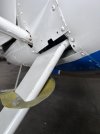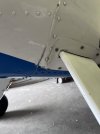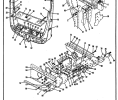Stelthav8r
Filing Flight Plan
- Joined
- Oct 17, 2023
- Messages
- 2
- Display Name
Display name:
Stelthav8r
Hello,
Found something on a previous skin repair on a 170. I’ve heard conflicting opinions. One says they believe it’s wrong because it was cut off and doesn't wrap around to the belly. The other says it’s a matter of opinion and is ok. Anyone have any solid guidance that I can reference? Picture of both sides attached.


Found something on a previous skin repair on a 170. I’ve heard conflicting opinions. One says they believe it’s wrong because it was cut off and doesn't wrap around to the belly. The other says it’s a matter of opinion and is ok. Anyone have any solid guidance that I can reference? Picture of both sides attached.



